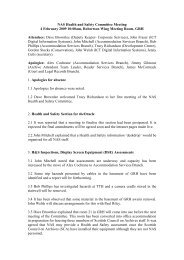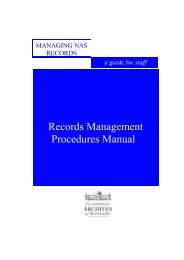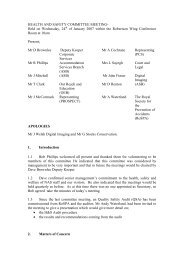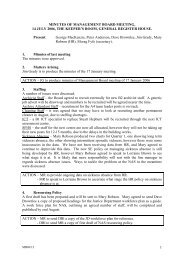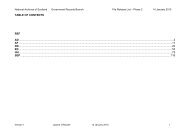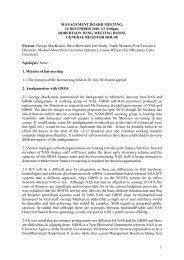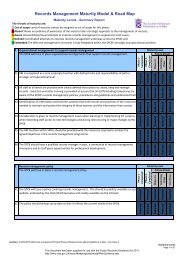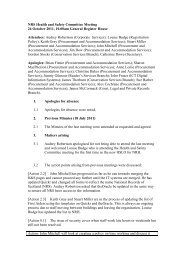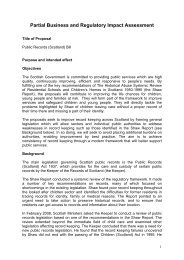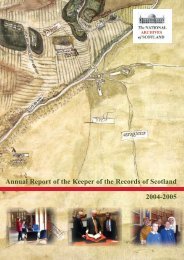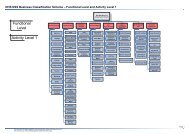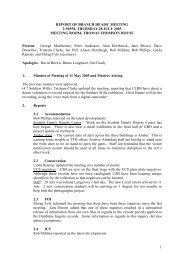Leaflet on General Register House - National Archives of Scotland
Leaflet on General Register House - National Archives of Scotland
Leaflet on General Register House - National Archives of Scotland
You also want an ePaper? Increase the reach of your titles
YUMPU automatically turns print PDFs into web optimized ePapers that Google loves.
GENERAL REGISTER HOUSE
GENERAL REGISTER HOUSETHE ‘ADAM DOME’The top-lit domed rotunda is the most importantroom in <strong>Register</strong> <strong>House</strong>. At 50 feet in diameter and80 feet in height, and with an area in excess <strong>of</strong>2000 square feet, it is also Adam’s highest andlargest surviving room. Inspired by the Panthe<strong>on</strong>in Rome, the <strong>on</strong>ly source <strong>of</strong> natural light is thecentral oculus, 15 feet in diameter. Originallydesigned as a public space giving access to differentareas <strong>of</strong> the building and for the storage <strong>of</strong> recordvolumes, it also served as a legal search roomfrom 1923 until 2007. The rotunda was renovatedin 2008 as part <strong>of</strong> the <strong>Scotland</strong>sPeople Centre forfamily history research.In 1785 Thomas Clayt<strong>on</strong> junior, an Edinburgh-basedplasterer who had worked for Robert Adam atInveraray Castle, was awarded the c<strong>on</strong>tract forcompleting the plasterwork according to Adam’sdesign. The eight medalli<strong>on</strong>s were chosen inL<strong>on</strong>d<strong>on</strong> by Adam himself, at a total cost <strong>of</strong> £33 12s.and were shipped to Edinburgh in 1786. Five <strong>of</strong>them are based <strong>on</strong> antique bas reliefs depictingRoman marriage and civic cerem<strong>on</strong>ies, while theremaining three appear to be c<strong>on</strong>temporarydesigns illustrating scenes from Greek myths andlegends. Their ic<strong>on</strong>ography is thereforeunc<strong>on</strong>nected with the purpose <strong>of</strong> the building.Adam’s introducti<strong>on</strong> <strong>of</strong> Scottish thistles into theanthemi<strong>on</strong> frieze forming the first band <strong>of</strong> ceilingdecorati<strong>on</strong> acknowledged the building’s nati<strong>on</strong>alidentity.
THE NATIONAL ARCHIVES OF SCOTLANDWe know from surviving accounts for painting therotunda ceiling that Adam’s original decorativescheme comprised a st<strong>on</strong>e coloured (ie <strong>of</strong>f-white)background, with the decorative details picked outin white. This scheme was c<strong>on</strong>firmed byinvestigati<strong>on</strong>s by Historic <strong>Scotland</strong> c<strong>on</strong>servators in2003 and 2007. They also established that the st<strong>on</strong>ecolour was subtly shaded rather than flat, and thatthe background <strong>of</strong> the medalli<strong>on</strong>s and the plasterornaments around the oculus had been painted ina delicate blueish-grey shade. St<strong>on</strong>e colour wasalso used <strong>on</strong> the rotunda walls and throughout themost <strong>of</strong> the rest <strong>of</strong> the building. A sample ispreserved in the west lobby <strong>of</strong> the rotunda.Adam favoured such m<strong>on</strong>ochromatic white andst<strong>on</strong>e-coloured schemes for libraries and halls,usually reserving polychromy and gilding for thedrawing rooms and dining rooms <strong>of</strong> his greathouses. Successive redecorati<strong>on</strong>s <strong>of</strong> the rotundafrom the mid-nineteenth century <strong>on</strong>wards,however, gave rise to more colourful schemes,derived from what was then understood to be theAdam style, but lacking the sophisticati<strong>on</strong> <strong>of</strong> theoriginal. While the present decorative scheme,completed in 2008, closely follows Adam’s originalc<strong>on</strong>cept, it also includes elements from laterversi<strong>on</strong>s, such as the gilding, which was firstintroduced in 1850.The cast-ir<strong>on</strong> railing surrounding the gallery wasdesigned by Adam, manufactured by Carr<strong>on</strong> & Co.<strong>of</strong> Falkirk, and installed in 1788.
GENERAL REGISTER HOUSESTATUE OF KING GEORGE IIIThe overlife-sized, standing statue <strong>of</strong> King George IIIin his cor<strong>on</strong>ati<strong>on</strong> robes was commissi<strong>on</strong>ed in 1787 byLord Frederick Campbell from his niece the amateursculptor Anne Seymour Damer (1749-1828). It wasoriginally placed in the centre <strong>of</strong> the rotunda in1795. The gilt metal crown and sceptre are byVulliamy <strong>of</strong> L<strong>on</strong>d<strong>on</strong>, the royal clockmaker, whosupplied the clock and wind dial for the building’sturrets. The statue was c<strong>on</strong>served in 2008.



